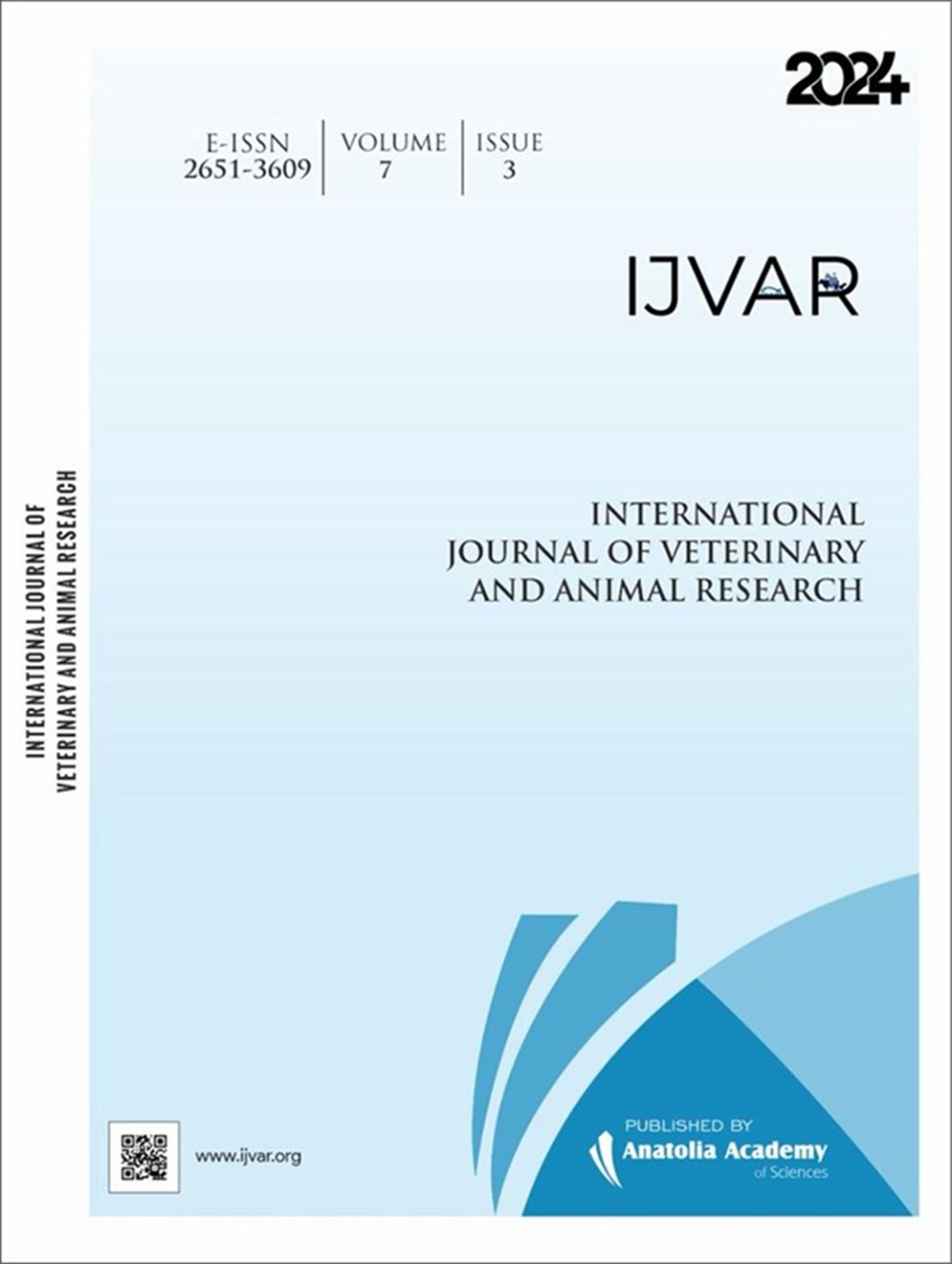Investigation of the Contribution of Different Antiseptic Solutions to Clinical Recovery in Uroretropropulsion Technique in Cats
Keywords:
Cat, Lugol's solution, Urethral obstructionAbstract
The aim of this study was to report the contribution of different antiseptics to clinical improvement during intravesical lavage in cats with urethral obstruction problems. Urethral obstruction (UO) is a problem mostly encountered in male cats, requiring urgent intervention with a high success rate in the inferior urinary system. A total of 42 cats of different breeds and ages were evaluated, and the first medical treatment was applied, but no urine output was detected. All cases were randomly divided into 3 different groups and one-time intravesical lavage was performed with different fluids: GI (0.9% saline), GII (Dimethyl sulphoxide) and GIII (lugol’s solution). The controls performed on the 7th, 14th, and 30th days of the study showed similar results in all cases, and no statistically significant difference was determined. As a result, it was concluded that lugol’s solution can be used as a new alternative to DMSO antiseptic, which is the only agent approved for treatment by the US Food and Drug Administration, when performing intravesical lavage in cats with urethral obstruction.
References
Breheny C, Blacklock KB, Gunn‐Moore D. 2022a. Approach to urethral obstruction in cats. Part 1: presentation and stabilisation. In Practice, 44 (7):372-384.
Breheny C, Blacklock KB, Gunn‐Moore D. 2022b. Approach to urethral obstruction in cats. Part 2: catheterising and postobstruction management. In Practice, 44(8):452-464.
Cooper ES, Lasley E, Daniels JB, Chew DJ. 2019. Incidence of bacteriuria at presentation and resulting from urinary catheterization in feline urethral obstruction. Journal of Veterinary Emergency and Critical Care, 29(5):472-477.
Dasgupta J, Tincello DG. 2009. Interstitial cystitis/bladder pain syndrome: an update. Maturitas, 64(4):212-217.
Delcaru C, Alexandru I, Podgoreanu P et al. 2016. Microbial biofilms in urinary tract infections and prostatitis: Etiology, pathogenicity, and combating strategies. Pathogens, 5(4):65.
Eisenberg BW, Waldrop JE, Allen SE et al. 2013. Evaluation of risk factors associated with recurrent obstruction in cats treated medically for urethral obstruction. Journal of the American Veterinary Medical Association, 243(8):1140-1146.
Fall M, Oberpenning F, Peeker R. 2008. Treatment of bladder pain syndrome/interstitial cystitis 2008: can we make evidence-based decisions? European Urology, 54(1):65-78.
Ferreira GS. 2013. Características epidemiológicas, clínicas e laboratoriais de gatos com sinais de trato urinário inferior. Journal of the American Veterinary Medical Association, 243(8):1140-1146.
Gerber B, Eichenberger S, Reusch CE et al. 2008. Guarded long-term prognosis in male cats with urethral obstruction. Journal of Feline Medicine and Surgery, 10(1):16-23.
Grønseth T, Ovchinnikov KV, Carlsen H. 2023. Lugol's solution and Gentian violet eradicate methicillin‐resistant Staphylococcus aureus biofilm in skin wound infections. International Wound Journal, 20(1):120-130.
Hanno P, Lin A, Nordling J et al. 2010. Bladder pain syndrome international consultation on incontinence. Neurourology and Urodynamics: Official Journal of the International Continence Society, 29(1):191-198.
Hetrick PF, Davidow EB. 2013. Initial treatment factors associated with feline urethral obstruction recurrence rate: 192 cases (2004–2010). Journal of the American Veterinary Medical Association, 243(4):512-519.
Kim R, Liu W, Chen X, Kreder KJ, Luo Y. 2011. Intravesical dimethyl sulfoxide inhibits acute and chronic bladder inflammation in transgenic experimental autoimmune cystitis models. BioMed Research International, 2011: 937061.
Lee JA, Drobatz KJ. 2006. Historical and physical parameters as predictors of severe hyperkalemia in male cats with urethral obstruction. Journal of Veterinary Emergency and Critical Care, 16(2):104-111.
Lulich J, Osborne C. 2013. Prazosin in cats with urethral obstruction. Journal of the American Veterinary Medical Association, 243(9):1240.
Osborne CA, Kruger JM, Lulich JP, Bartges JW, Polzin DJ. 1996. Medical management of feline urethral obstruction. Veterinary Clinics Small Animal Practice, 26 (3):483-498.
Reineke EL, Thomas EK, Syring RS, Savini J, Drobatz KJ. 2017. The effect of prazosin on outcome in feline urethral obstruction. Journal of Veterinary Emergency and Critical Care, 27(4):387-396.
Segev G, Livne H, Ranen E, Lavy E. 2011. Urethral obstruction in cats: predisposing factors, clinical, clinicopathological characteristics and prognosis. Journal of Feline Medicine and Surgery, 13(2):101-108.
Soler R, Bruschini H, Truzzi JC et al. 2008. Urinary glycosaminoglycans excretion and the effect of dimethyl sulfoxide in an experimental model of non-bacterial cystitis. Internal Brazial Journal Urol, 34:503-511.
Taranu T, Constantin MM, Toader MP, Esanu I, Mocanu M. 2018. The benefits of using the Iodine solution in the treatment of acne at pregnant women. Reviev Chimestry, 69:2343-2345.
Downloads
Published
How to Cite
Issue
Section
License
Copyright (c) 2024 International Journal of Veterinary and Animal Research (IJVAR)

This work is licensed under a Creative Commons Attribution-NonCommercial-NoDerivatives 4.0 International License.







